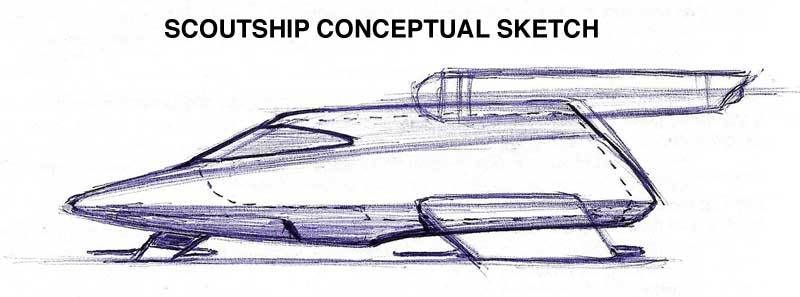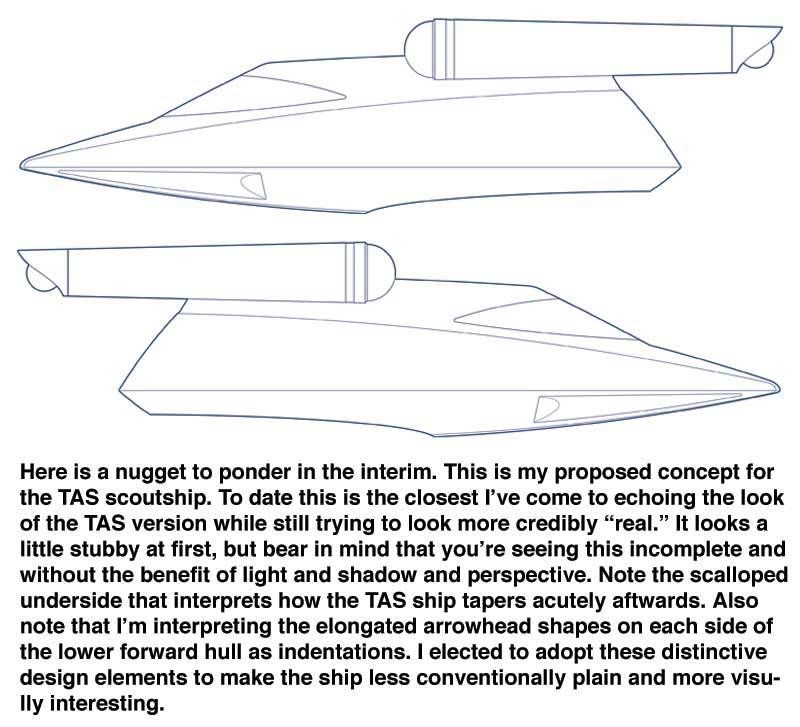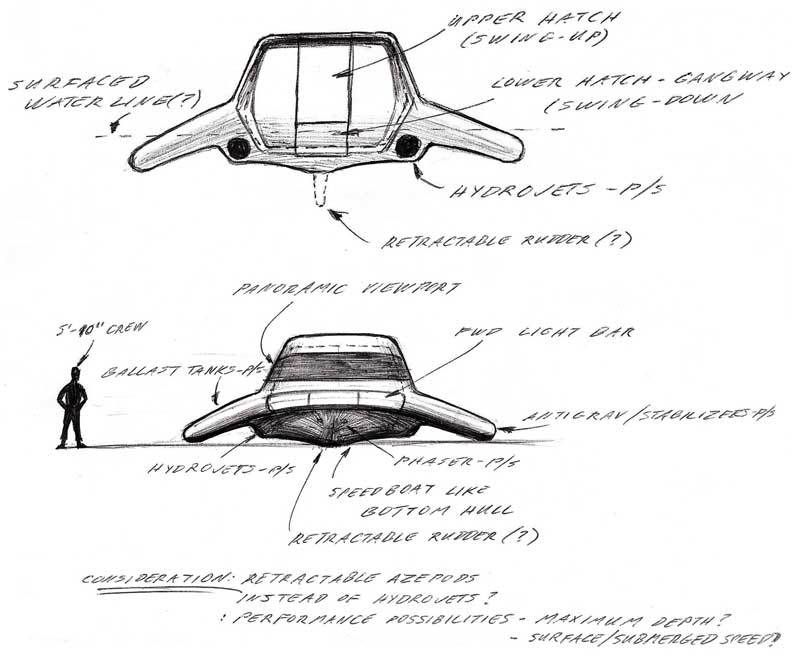A couple of random ideas on the aquashuttle:
The "ventral windows" concept might tie into lighting arrangements. In real submersibles, ventral windows are sometimes utilized by lying prone, in a "deathbed" type of compartment that is isolated from the larger cabin so that the observation area can be kept dark while the main cabin is well lit up. The TAS shuttle has several prominent, large squares on the floor that might be access hatches to an underfloor crawlspace featuring this ventral window - plus, no doubt, a series of manipulators for accessing and studying the sea bottom. The waterlock facilities could adjoin: absent forcefield magic, they could act like simple "moon pools", provided that the counterpressure was sufficiently increased in this ventral compartment, and present the usual Trek magic, the moon pool arrangement could still be more practical than a side or aft or top hatch.
Propulsion might indeed be by waterjet or exposed Azipod-style propeller. I'd suggest something more refined, though - such as a magnetohydrodynamic drive featuring no moving parts. Fine control of the fluid flows just outside the hull might also allow for very high underwater speed, on the order of a hundred kilometers per hour, as with the crude shockwave riders of today such as the Shkval.
Also, I'd interpret the down-sloping lateral parts of the hull as facilitating a hovercraft/ekranoplan mode of air-cushion, surface-skimming operations where the usual gravitic trickery can be shut down yet low-friction hovering can still be maintained. And I'd replace ballast with reverse gravitics, as the latter technology would probably be more practical in the future: there'd be natural positive buoyancy built to the craft at maximum operating depth, as a safety factor, and if power failed, the thing would come up on its own. (Some downforce could also be added by hull shape, so that the gravitics could run at lesser downforce power when the craft moves forward.)
As I'm sort of fond of the strange original shape, I'd probably preserve the prominent nacelles: the original ain't hydrodynamic enough that their removal would make that much of a difference, and it might be argued that the nacelles need to be exposed in this inconvenient manner in order to work at all. Just streamline them a bit. Indeed, they might be the source of the gravitic downforce at submerged mode, and of liftforce at flight mode - it would be no shame to have them as ugly exterior cylinders, then, as this is what ballast often looks like on today's (admittedly low-speed) subs.
Well, to the right of Mudd, the farthest craft looks like Carter Winston's ship; if similar (or even Carter's very ship, not yet ditched overboard or donated to any starbase!), we might expect this to have relatively high speed and great range.
In turn, the nearest craft to Mudd's right, of which only a bow quarter is seen, appears to be the lenticular scoutcraft that was carefully sketched but never made it to an episode - it looked much like Cousteau's SP-350 saucer, although moving butt first. Unlike all the others, this craft lacked nacelles, and might thus be argued to have been the light planetary flier.
Also, one might argue that the "almost Class F" in fact is nothing of the sort, as it has the odd quadruped landing gear and strangely rigged nacelles plus the different impulse engine arrangement. If this craft is taken to be larger than Class F, then the "heavy lander" could easily be two-level, or at least 1.5-level, as its other scenes suggest.
Say, the lander could have a two-person forward flight deck as seen in the interior, and a matching aft deck, but between them would be a short ladder down to the side door. Below the aft deck would be the main machinery, including an impulse engine that only manifests as a narrow red strip at the stern "kink"; this machinery would be half a deck high. Within the nose could be more of the key machinery and instrumentation, possibly with an accessway and/or a small boat-style berthing space with two bunks.
Such a multilevel craft could be an earlier model, its machinery not yet miniaturized enough to allow for the simple elegance of the boxy Class F. Its curvy concessions to aerodynamics would also indicate an older design.
Timo Saloniemi
The "ventral windows" concept might tie into lighting arrangements. In real submersibles, ventral windows are sometimes utilized by lying prone, in a "deathbed" type of compartment that is isolated from the larger cabin so that the observation area can be kept dark while the main cabin is well lit up. The TAS shuttle has several prominent, large squares on the floor that might be access hatches to an underfloor crawlspace featuring this ventral window - plus, no doubt, a series of manipulators for accessing and studying the sea bottom. The waterlock facilities could adjoin: absent forcefield magic, they could act like simple "moon pools", provided that the counterpressure was sufficiently increased in this ventral compartment, and present the usual Trek magic, the moon pool arrangement could still be more practical than a side or aft or top hatch.
Propulsion might indeed be by waterjet or exposed Azipod-style propeller. I'd suggest something more refined, though - such as a magnetohydrodynamic drive featuring no moving parts. Fine control of the fluid flows just outside the hull might also allow for very high underwater speed, on the order of a hundred kilometers per hour, as with the crude shockwave riders of today such as the Shkval.
Also, I'd interpret the down-sloping lateral parts of the hull as facilitating a hovercraft/ekranoplan mode of air-cushion, surface-skimming operations where the usual gravitic trickery can be shut down yet low-friction hovering can still be maintained. And I'd replace ballast with reverse gravitics, as the latter technology would probably be more practical in the future: there'd be natural positive buoyancy built to the craft at maximum operating depth, as a safety factor, and if power failed, the thing would come up on its own. (Some downforce could also be added by hull shape, so that the gravitics could run at lesser downforce power when the craft moves forward.)
As I'm sort of fond of the strange original shape, I'd probably preserve the prominent nacelles: the original ain't hydrodynamic enough that their removal would make that much of a difference, and it might be argued that the nacelles need to be exposed in this inconvenient manner in order to work at all. Just streamline them a bit. Indeed, they might be the source of the gravitic downforce at submerged mode, and of liftforce at flight mode - it would be no shame to have them as ugly exterior cylinders, then, as this is what ballast often looks like on today's (admittedly low-speed) subs.
That second hilighted passage is interesting in its own way because nowhere in "The Slaver Weapon" or ADF's adaptation is the Copernicus referred to as a small superfast scoutship. Fans just made that connection. The heavy lander connection is obvious although the term was never used in the aired episode.
However, while one of the craft seen in a panning shot of the flight deck in TAS could be taken as similar to the TOS Class F design none of the others looks like a light planetary flier.
Well, to the right of Mudd, the farthest craft looks like Carter Winston's ship; if similar (or even Carter's very ship, not yet ditched overboard or donated to any starbase!), we might expect this to have relatively high speed and great range.
In turn, the nearest craft to Mudd's right, of which only a bow quarter is seen, appears to be the lenticular scoutcraft that was carefully sketched but never made it to an episode - it looked much like Cousteau's SP-350 saucer, although moving butt first. Unlike all the others, this craft lacked nacelles, and might thus be argued to have been the light planetary flier.
Also, one might argue that the "almost Class F" in fact is nothing of the sort, as it has the odd quadruped landing gear and strangely rigged nacelles plus the different impulse engine arrangement. If this craft is taken to be larger than Class F, then the "heavy lander" could easily be two-level, or at least 1.5-level, as its other scenes suggest.
Say, the lander could have a two-person forward flight deck as seen in the interior, and a matching aft deck, but between them would be a short ladder down to the side door. Below the aft deck would be the main machinery, including an impulse engine that only manifests as a narrow red strip at the stern "kink"; this machinery would be half a deck high. Within the nose could be more of the key machinery and instrumentation, possibly with an accessway and/or a small boat-style berthing space with two bunks.
Such a multilevel craft could be an earlier model, its machinery not yet miniaturized enough to allow for the simple elegance of the boxy Class F. Its curvy concessions to aerodynamics would also indicate an older design.
Timo Saloniemi








